University Customs Regulatory Compliance Management Assignment
VerifiedAdded on 2019/10/31
|11
|2620
|301
Report
AI Summary
This report provides an in-depth analysis of customs regulatory compliance, emphasizing its significance in international trade and the Australian context. It explores the multifaceted role of customs administrations, transitioning from a gatekeeper to a facilitator of trade through risk-based compliance management. The report highlights the importance of compliance management, risk assessment, and the Australian Trusted Trader program. It examines customs valuation, transfer pricing, and the strategies employed by the Australian Border Force. The report provides a comprehensive overview of the legal and regulatory framework governing customs operations and the benefits of compliance. It also underscores the consequences of non-compliance and the importance of continuous monitoring and adaptation to evolving trade policies.
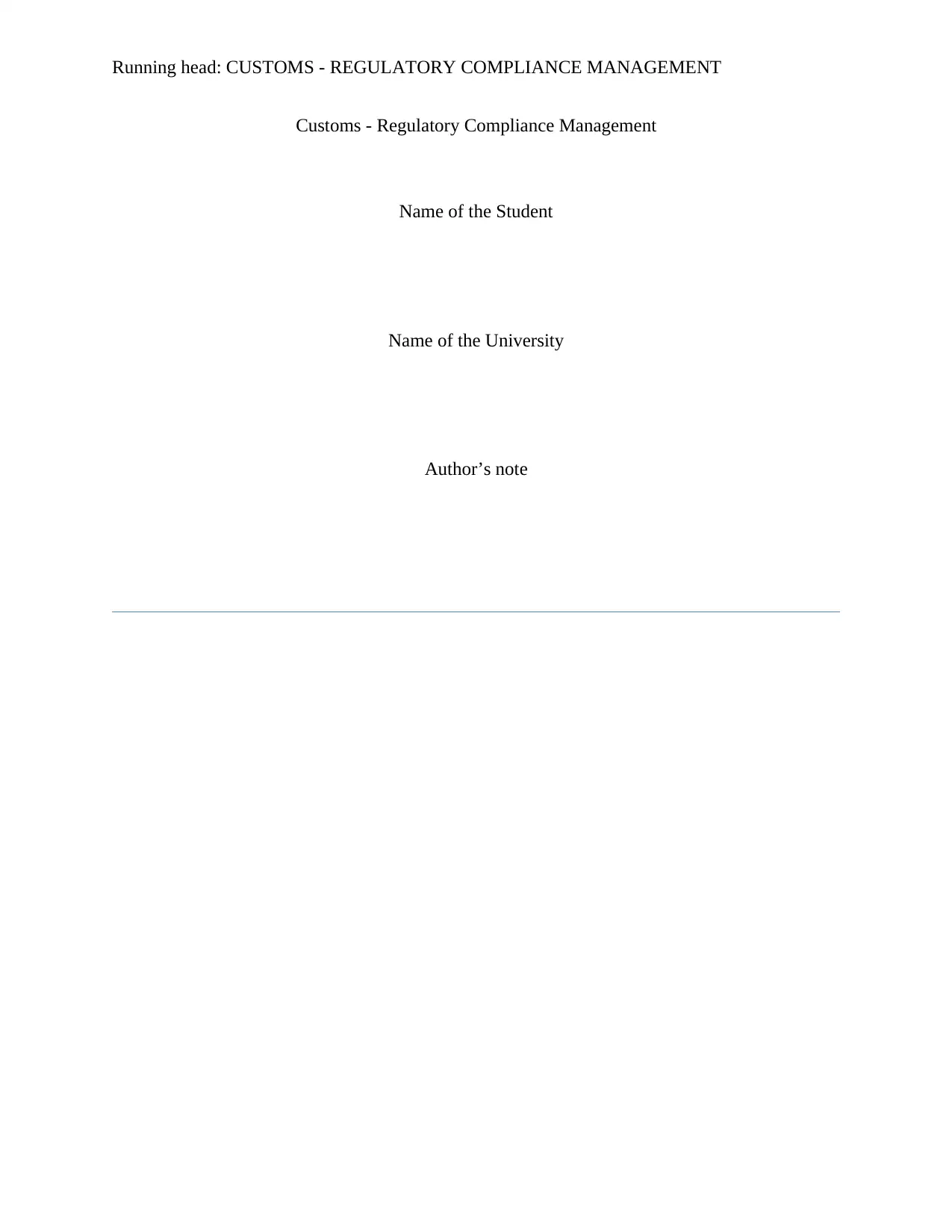
Running head: CUSTOMS - REGULATORY COMPLIANCE MANAGEMENT
Customs - Regulatory Compliance Management
Name of the Student
Name of the University
Author’s note
Customs - Regulatory Compliance Management
Name of the Student
Name of the University
Author’s note
Paraphrase This Document
Need a fresh take? Get an instant paraphrase of this document with our AI Paraphraser
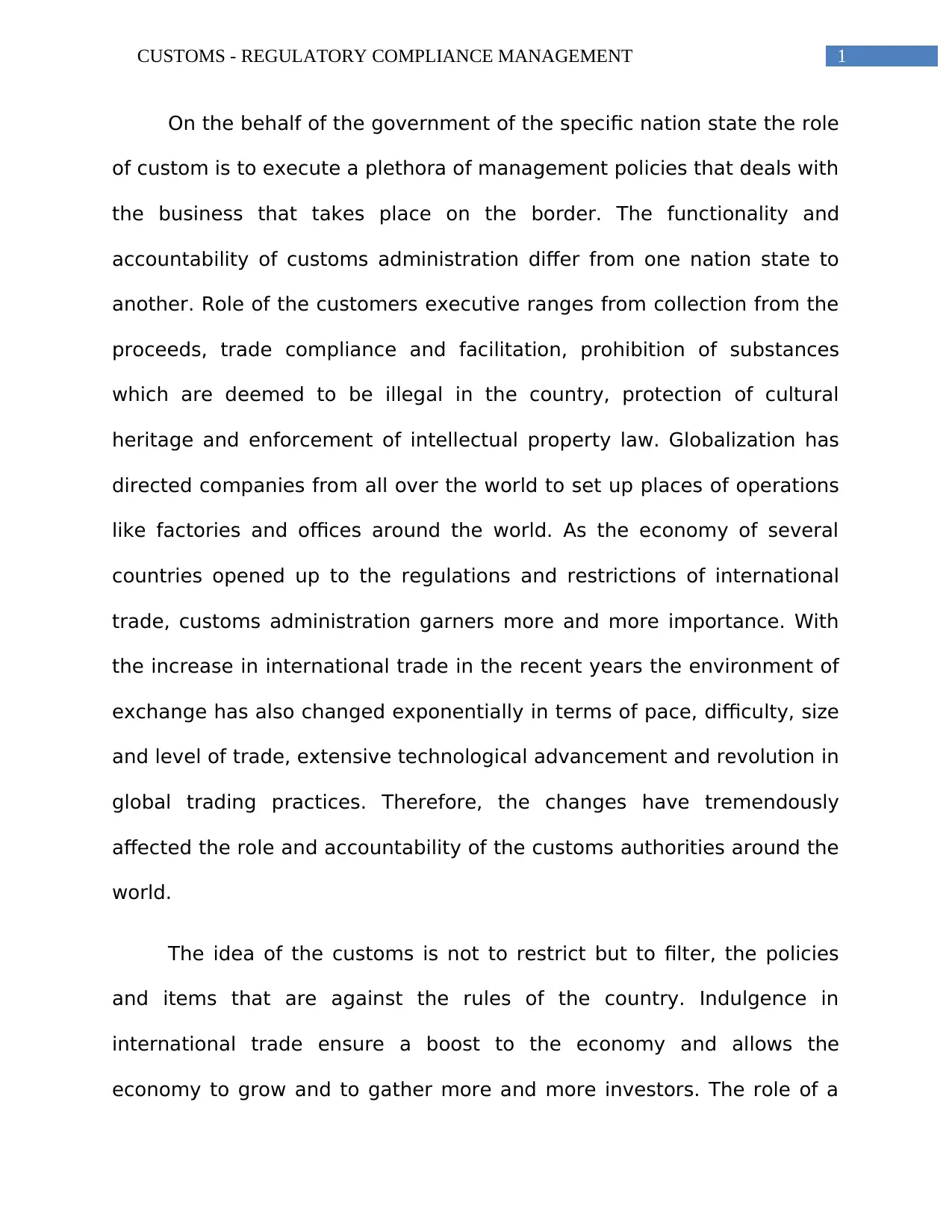
1CUSTOMS - REGULATORY COMPLIANCE MANAGEMENT
On the behalf of the government of the specific nation state the role
of custom is to execute a plethora of management policies that deals with
the business that takes place on the border. The functionality and
accountability of customs administration differ from one nation state to
another. Role of the customers executive ranges from collection from the
proceeds, trade compliance and facilitation, prohibition of substances
which are deemed to be illegal in the country, protection of cultural
heritage and enforcement of intellectual property law. Globalization has
directed companies from all over the world to set up places of operations
like factories and offices around the world. As the economy of several
countries opened up to the regulations and restrictions of international
trade, customs administration garners more and more importance. With
the increase in international trade in the recent years the environment of
exchange has also changed exponentially in terms of pace, difficulty, size
and level of trade, extensive technological advancement and revolution in
global trading practices. Therefore, the changes have tremendously
affected the role and accountability of the customs authorities around the
world.
The idea of the customs is not to restrict but to filter, the policies
and items that are against the rules of the country. Indulgence in
international trade ensure a boost to the economy and allows the
economy to grow and to gather more and more investors. The role of a
On the behalf of the government of the specific nation state the role
of custom is to execute a plethora of management policies that deals with
the business that takes place on the border. The functionality and
accountability of customs administration differ from one nation state to
another. Role of the customers executive ranges from collection from the
proceeds, trade compliance and facilitation, prohibition of substances
which are deemed to be illegal in the country, protection of cultural
heritage and enforcement of intellectual property law. Globalization has
directed companies from all over the world to set up places of operations
like factories and offices around the world. As the economy of several
countries opened up to the regulations and restrictions of international
trade, customs administration garners more and more importance. With
the increase in international trade in the recent years the environment of
exchange has also changed exponentially in terms of pace, difficulty, size
and level of trade, extensive technological advancement and revolution in
global trading practices. Therefore, the changes have tremendously
affected the role and accountability of the customs authorities around the
world.
The idea of the customs is not to restrict but to filter, the policies
and items that are against the rules of the country. Indulgence in
international trade ensure a boost to the economy and allows the
economy to grow and to gather more and more investors. The role of a
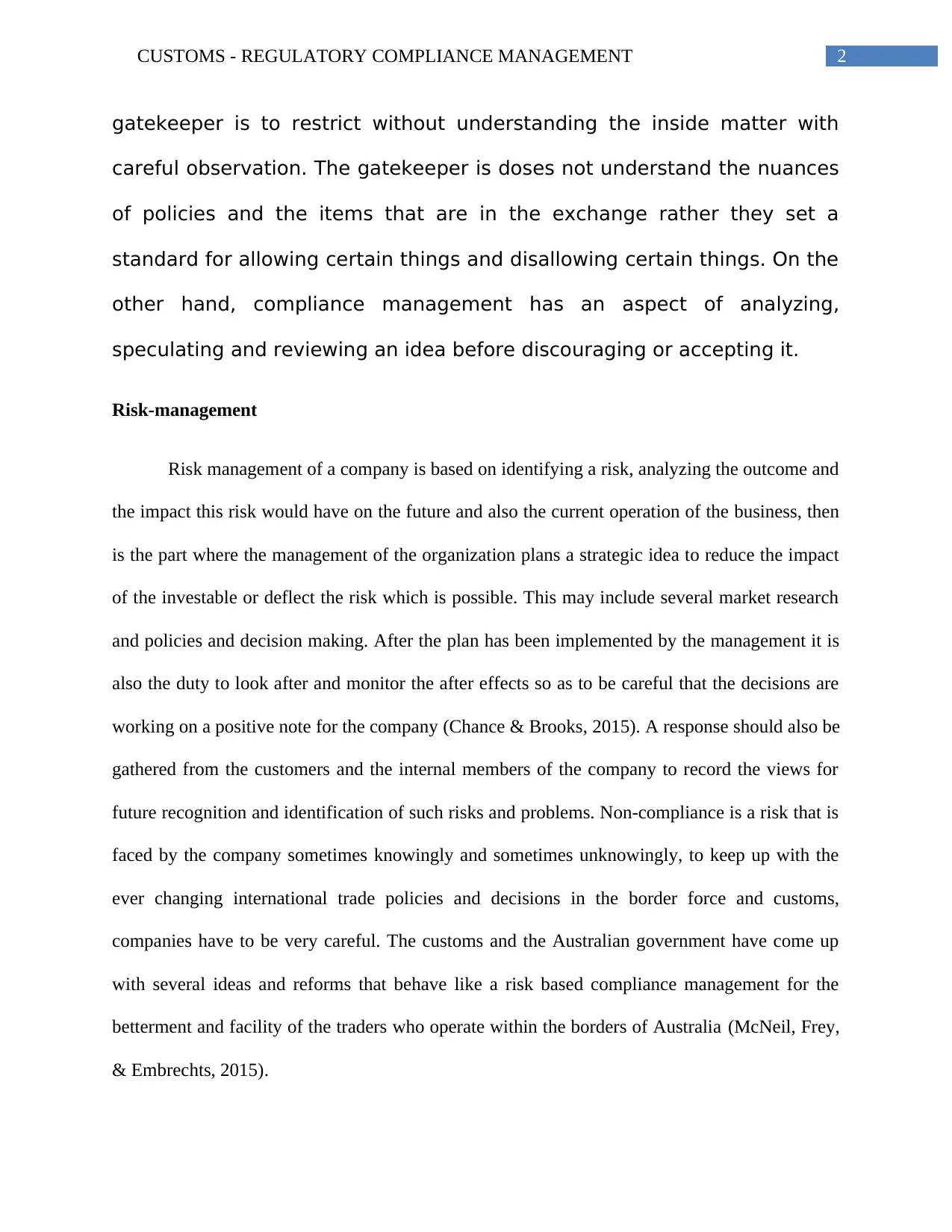
2CUSTOMS - REGULATORY COMPLIANCE MANAGEMENT
gatekeeper is to restrict without understanding the inside matter with
careful observation. The gatekeeper is doses not understand the nuances
of policies and the items that are in the exchange rather they set a
standard for allowing certain things and disallowing certain things. On the
other hand, compliance management has an aspect of analyzing,
speculating and reviewing an idea before discouraging or accepting it.
Risk-management
Risk management of a company is based on identifying a risk, analyzing the outcome and
the impact this risk would have on the future and also the current operation of the business, then
is the part where the management of the organization plans a strategic idea to reduce the impact
of the investable or deflect the risk which is possible. This may include several market research
and policies and decision making. After the plan has been implemented by the management it is
also the duty to look after and monitor the after effects so as to be careful that the decisions are
working on a positive note for the company (Chance & Brooks, 2015). A response should also be
gathered from the customers and the internal members of the company to record the views for
future recognition and identification of such risks and problems. Non-compliance is a risk that is
faced by the company sometimes knowingly and sometimes unknowingly, to keep up with the
ever changing international trade policies and decisions in the border force and customs,
companies have to be very careful. The customs and the Australian government have come up
with several ideas and reforms that behave like a risk based compliance management for the
betterment and facility of the traders who operate within the borders of Australia (McNeil, Frey,
& Embrechts, 2015).
gatekeeper is to restrict without understanding the inside matter with
careful observation. The gatekeeper is doses not understand the nuances
of policies and the items that are in the exchange rather they set a
standard for allowing certain things and disallowing certain things. On the
other hand, compliance management has an aspect of analyzing,
speculating and reviewing an idea before discouraging or accepting it.
Risk-management
Risk management of a company is based on identifying a risk, analyzing the outcome and
the impact this risk would have on the future and also the current operation of the business, then
is the part where the management of the organization plans a strategic idea to reduce the impact
of the investable or deflect the risk which is possible. This may include several market research
and policies and decision making. After the plan has been implemented by the management it is
also the duty to look after and monitor the after effects so as to be careful that the decisions are
working on a positive note for the company (Chance & Brooks, 2015). A response should also be
gathered from the customers and the internal members of the company to record the views for
future recognition and identification of such risks and problems. Non-compliance is a risk that is
faced by the company sometimes knowingly and sometimes unknowingly, to keep up with the
ever changing international trade policies and decisions in the border force and customs,
companies have to be very careful. The customs and the Australian government have come up
with several ideas and reforms that behave like a risk based compliance management for the
betterment and facility of the traders who operate within the borders of Australia (McNeil, Frey,
& Embrechts, 2015).
⊘ This is a preview!⊘
Do you want full access?
Subscribe today to unlock all pages.

Trusted by 1+ million students worldwide
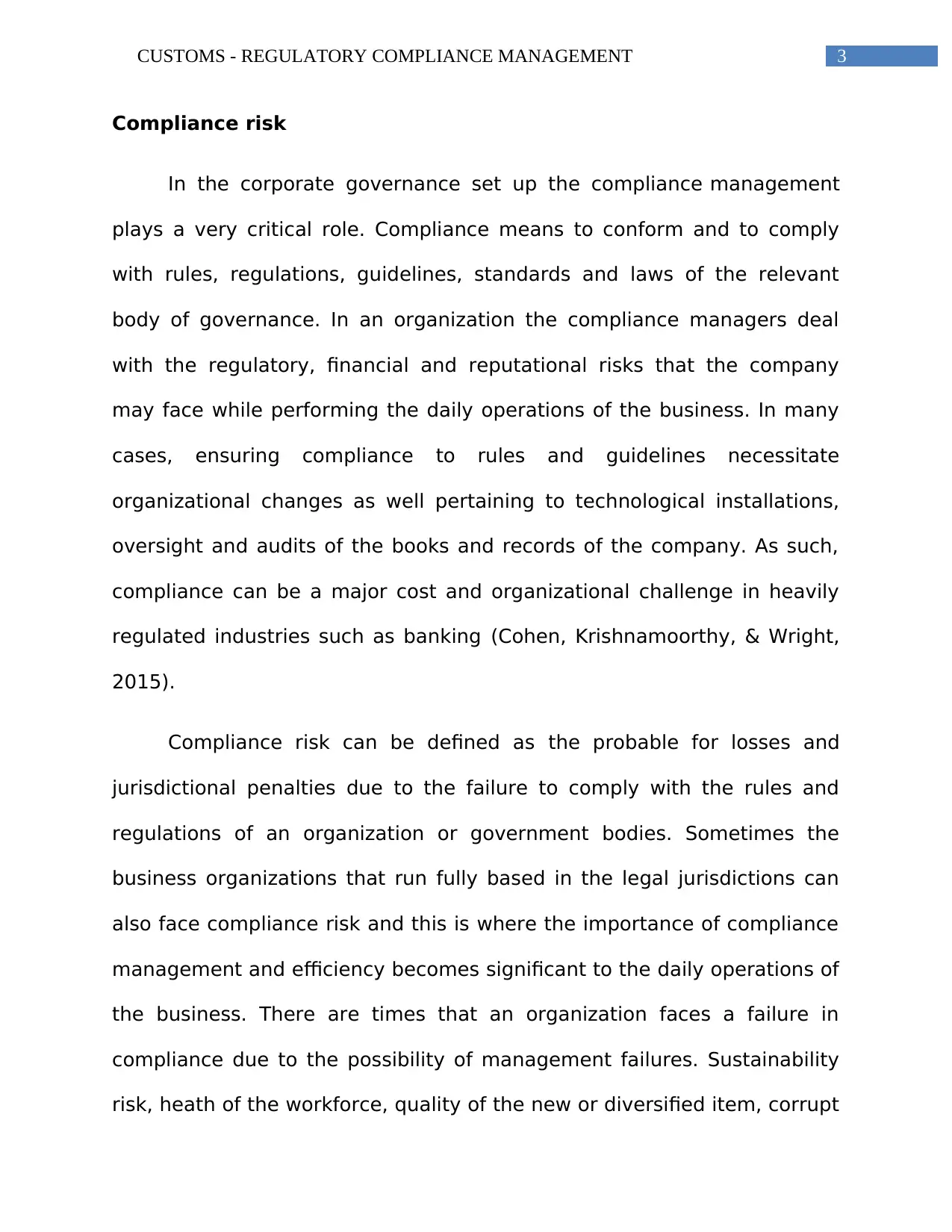
3CUSTOMS - REGULATORY COMPLIANCE MANAGEMENT
Compliance risk
In the corporate governance set up the compliance management
plays a very critical role. Compliance means to conform and to comply
with rules, regulations, guidelines, standards and laws of the relevant
body of governance. In an organization the compliance managers deal
with the regulatory, financial and reputational risks that the company
may face while performing the daily operations of the business. In many
cases, ensuring compliance to rules and guidelines necessitate
organizational changes as well pertaining to technological installations,
oversight and audits of the books and records of the company. As such,
compliance can be a major cost and organizational challenge in heavily
regulated industries such as banking (Cohen, Krishnamoorthy, & Wright,
2015).
Compliance risk can be defined as the probable for losses and
jurisdictional penalties due to the failure to comply with the rules and
regulations of an organization or government bodies. Sometimes the
business organizations that run fully based in the legal jurisdictions can
also face compliance risk and this is where the importance of compliance
management and efficiency becomes significant to the daily operations of
the business. There are times that an organization faces a failure in
compliance due to the possibility of management failures. Sustainability
risk, heath of the workforce, quality of the new or diversified item, corrupt
Compliance risk
In the corporate governance set up the compliance management
plays a very critical role. Compliance means to conform and to comply
with rules, regulations, guidelines, standards and laws of the relevant
body of governance. In an organization the compliance managers deal
with the regulatory, financial and reputational risks that the company
may face while performing the daily operations of the business. In many
cases, ensuring compliance to rules and guidelines necessitate
organizational changes as well pertaining to technological installations,
oversight and audits of the books and records of the company. As such,
compliance can be a major cost and organizational challenge in heavily
regulated industries such as banking (Cohen, Krishnamoorthy, & Wright,
2015).
Compliance risk can be defined as the probable for losses and
jurisdictional penalties due to the failure to comply with the rules and
regulations of an organization or government bodies. Sometimes the
business organizations that run fully based in the legal jurisdictions can
also face compliance risk and this is where the importance of compliance
management and efficiency becomes significant to the daily operations of
the business. There are times that an organization faces a failure in
compliance due to the possibility of management failures. Sustainability
risk, heath of the workforce, quality of the new or diversified item, corrupt
Paraphrase This Document
Need a fresh take? Get an instant paraphrase of this document with our AI Paraphraser
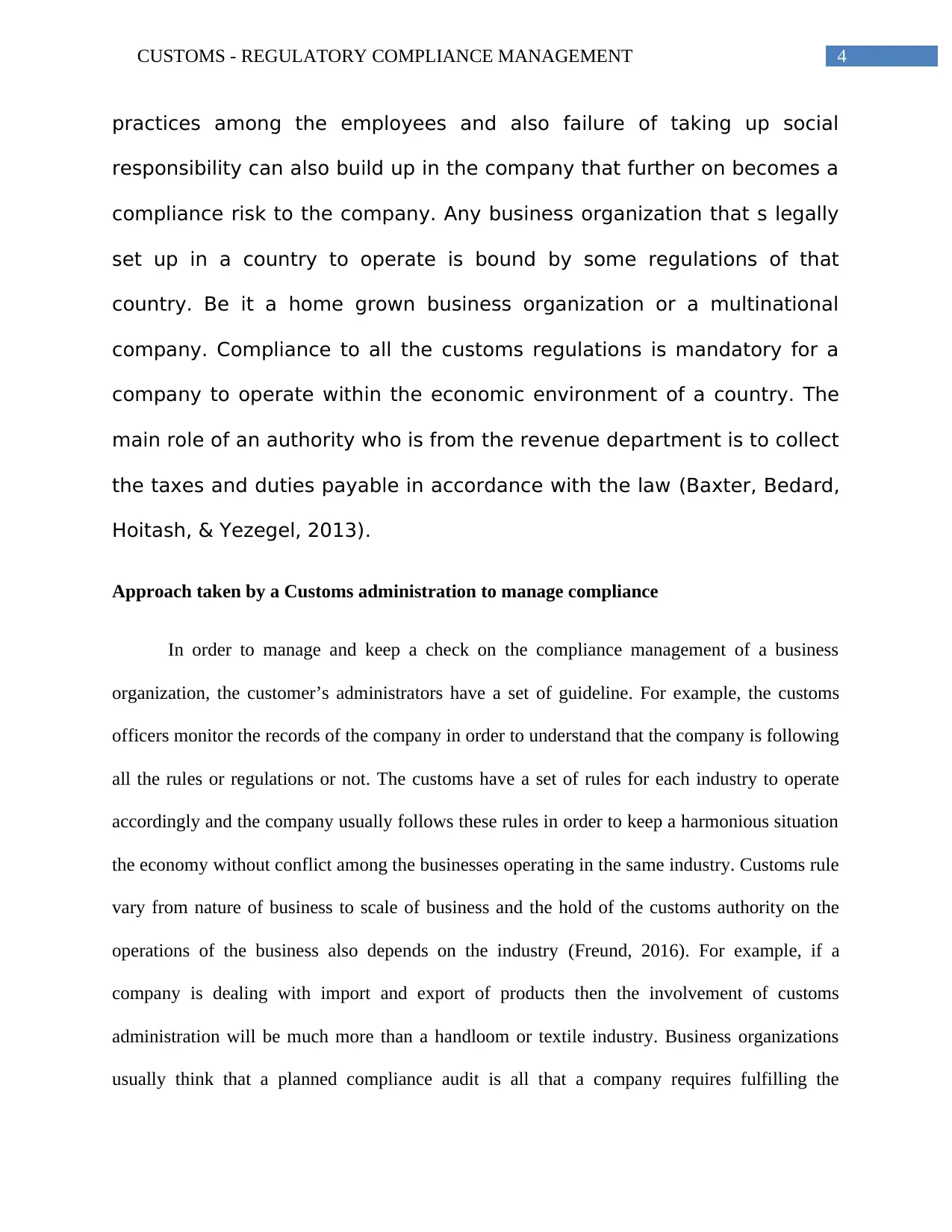
4CUSTOMS - REGULATORY COMPLIANCE MANAGEMENT
practices among the employees and also failure of taking up social
responsibility can also build up in the company that further on becomes a
compliance risk to the company. Any business organization that s legally
set up in a country to operate is bound by some regulations of that
country. Be it a home grown business organization or a multinational
company. Compliance to all the customs regulations is mandatory for a
company to operate within the economic environment of a country. The
main role of an authority who is from the revenue department is to collect
the taxes and duties payable in accordance with the law (Baxter, Bedard,
Hoitash, & Yezegel, 2013).
Approach taken by a Customs administration to manage compliance
In order to manage and keep a check on the compliance management of a business
organization, the customer’s administrators have a set of guideline. For example, the customs
officers monitor the records of the company in order to understand that the company is following
all the rules or regulations or not. The customs have a set of rules for each industry to operate
accordingly and the company usually follows these rules in order to keep a harmonious situation
the economy without conflict among the businesses operating in the same industry. Customs rule
vary from nature of business to scale of business and the hold of the customs authority on the
operations of the business also depends on the industry (Freund, 2016). For example, if a
company is dealing with import and export of products then the involvement of customs
administration will be much more than a handloom or textile industry. Business organizations
usually think that a planned compliance audit is all that a company requires fulfilling the
practices among the employees and also failure of taking up social
responsibility can also build up in the company that further on becomes a
compliance risk to the company. Any business organization that s legally
set up in a country to operate is bound by some regulations of that
country. Be it a home grown business organization or a multinational
company. Compliance to all the customs regulations is mandatory for a
company to operate within the economic environment of a country. The
main role of an authority who is from the revenue department is to collect
the taxes and duties payable in accordance with the law (Baxter, Bedard,
Hoitash, & Yezegel, 2013).
Approach taken by a Customs administration to manage compliance
In order to manage and keep a check on the compliance management of a business
organization, the customer’s administrators have a set of guideline. For example, the customs
officers monitor the records of the company in order to understand that the company is following
all the rules or regulations or not. The customs have a set of rules for each industry to operate
accordingly and the company usually follows these rules in order to keep a harmonious situation
the economy without conflict among the businesses operating in the same industry. Customs rule
vary from nature of business to scale of business and the hold of the customs authority on the
operations of the business also depends on the industry (Freund, 2016). For example, if a
company is dealing with import and export of products then the involvement of customs
administration will be much more than a handloom or textile industry. Business organizations
usually think that a planned compliance audit is all that a company requires fulfilling the
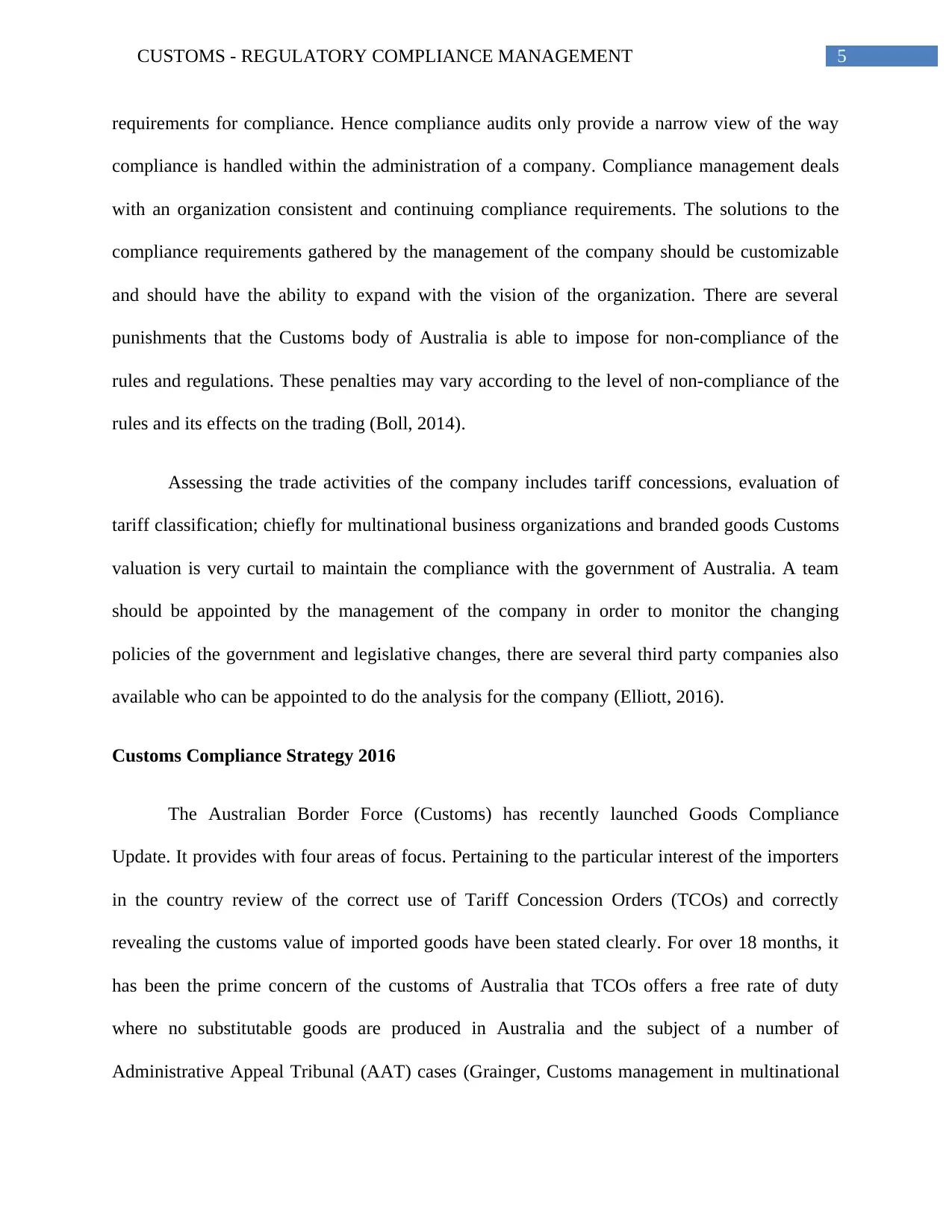
5CUSTOMS - REGULATORY COMPLIANCE MANAGEMENT
requirements for compliance. Hence compliance audits only provide a narrow view of the way
compliance is handled within the administration of a company. Compliance management deals
with an organization consistent and continuing compliance requirements. The solutions to the
compliance requirements gathered by the management of the company should be customizable
and should have the ability to expand with the vision of the organization. There are several
punishments that the Customs body of Australia is able to impose for non-compliance of the
rules and regulations. These penalties may vary according to the level of non-compliance of the
rules and its effects on the trading (Boll, 2014).
Assessing the trade activities of the company includes tariff concessions, evaluation of
tariff classification; chiefly for multinational business organizations and branded goods Customs
valuation is very curtail to maintain the compliance with the government of Australia. A team
should be appointed by the management of the company in order to monitor the changing
policies of the government and legislative changes, there are several third party companies also
available who can be appointed to do the analysis for the company (Elliott, 2016).
Customs Compliance Strategy 2016
The Australian Border Force (Customs) has recently launched Goods Compliance
Update. It provides with four areas of focus. Pertaining to the particular interest of the importers
in the country review of the correct use of Tariff Concession Orders (TCOs) and correctly
revealing the customs value of imported goods have been stated clearly. For over 18 months, it
has been the prime concern of the customs of Australia that TCOs offers a free rate of duty
where no substitutable goods are produced in Australia and the subject of a number of
Administrative Appeal Tribunal (AAT) cases (Grainger, Customs management in multinational
requirements for compliance. Hence compliance audits only provide a narrow view of the way
compliance is handled within the administration of a company. Compliance management deals
with an organization consistent and continuing compliance requirements. The solutions to the
compliance requirements gathered by the management of the company should be customizable
and should have the ability to expand with the vision of the organization. There are several
punishments that the Customs body of Australia is able to impose for non-compliance of the
rules and regulations. These penalties may vary according to the level of non-compliance of the
rules and its effects on the trading (Boll, 2014).
Assessing the trade activities of the company includes tariff concessions, evaluation of
tariff classification; chiefly for multinational business organizations and branded goods Customs
valuation is very curtail to maintain the compliance with the government of Australia. A team
should be appointed by the management of the company in order to monitor the changing
policies of the government and legislative changes, there are several third party companies also
available who can be appointed to do the analysis for the company (Elliott, 2016).
Customs Compliance Strategy 2016
The Australian Border Force (Customs) has recently launched Goods Compliance
Update. It provides with four areas of focus. Pertaining to the particular interest of the importers
in the country review of the correct use of Tariff Concession Orders (TCOs) and correctly
revealing the customs value of imported goods have been stated clearly. For over 18 months, it
has been the prime concern of the customs of Australia that TCOs offers a free rate of duty
where no substitutable goods are produced in Australia and the subject of a number of
Administrative Appeal Tribunal (AAT) cases (Grainger, Customs management in multinational
⊘ This is a preview!⊘
Do you want full access?
Subscribe today to unlock all pages.

Trusted by 1+ million students worldwide
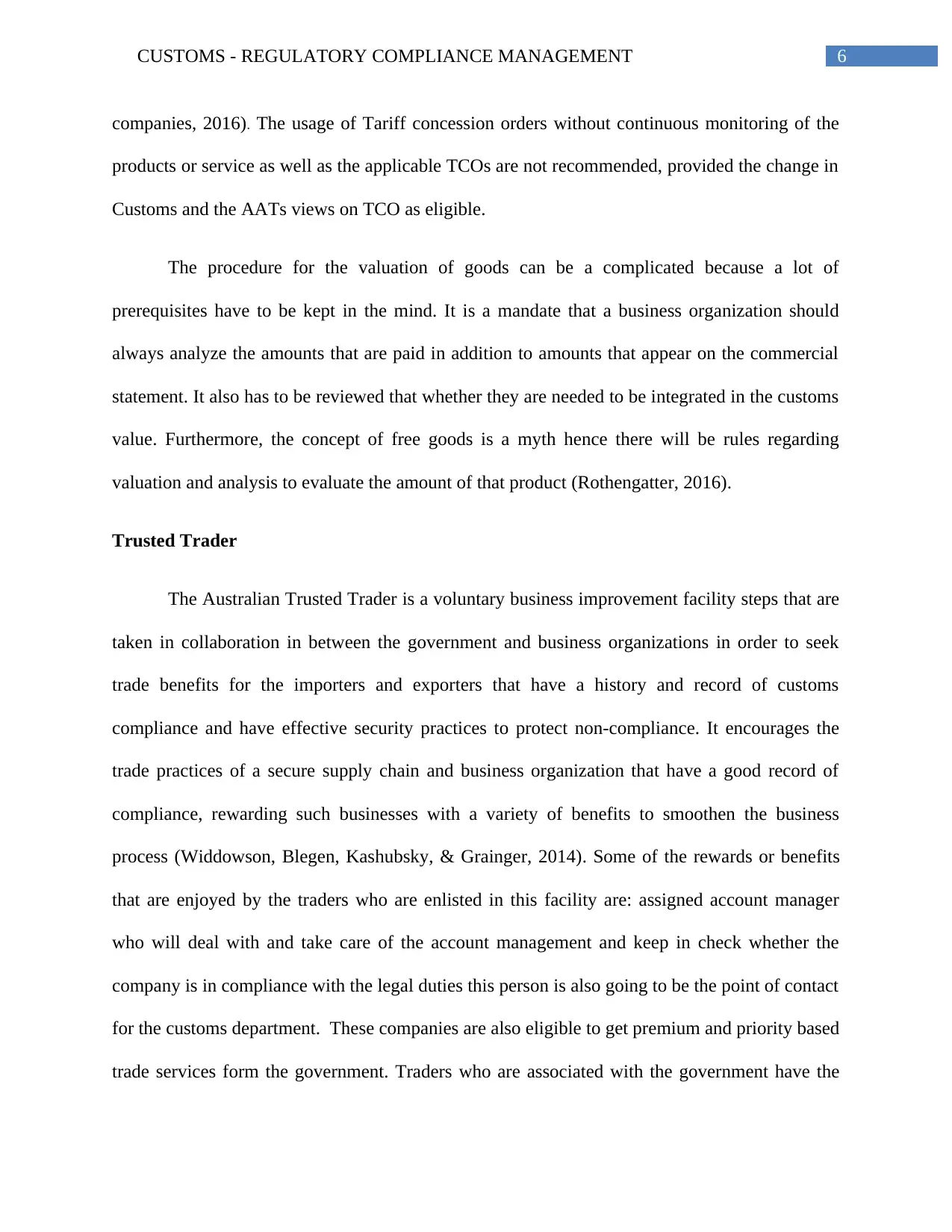
6CUSTOMS - REGULATORY COMPLIANCE MANAGEMENT
companies, 2016). The usage of Tariff concession orders without continuous monitoring of the
products or service as well as the applicable TCOs are not recommended, provided the change in
Customs and the AATs views on TCO as eligible.
The procedure for the valuation of goods can be a complicated because a lot of
prerequisites have to be kept in the mind. It is a mandate that a business organization should
always analyze the amounts that are paid in addition to amounts that appear on the commercial
statement. It also has to be reviewed that whether they are needed to be integrated in the customs
value. Furthermore, the concept of free goods is a myth hence there will be rules regarding
valuation and analysis to evaluate the amount of that product (Rothengatter, 2016).
Trusted Trader
The Australian Trusted Trader is a voluntary business improvement facility steps that are
taken in collaboration in between the government and business organizations in order to seek
trade benefits for the importers and exporters that have a history and record of customs
compliance and have effective security practices to protect non-compliance. It encourages the
trade practices of a secure supply chain and business organization that have a good record of
compliance, rewarding such businesses with a variety of benefits to smoothen the business
process (Widdowson, Blegen, Kashubsky, & Grainger, 2014). Some of the rewards or benefits
that are enjoyed by the traders who are enlisted in this facility are: assigned account manager
who will deal with and take care of the account management and keep in check whether the
company is in compliance with the legal duties this person is also going to be the point of contact
for the customs department. These companies are also eligible to get premium and priority based
trade services form the government. Traders who are associated with the government have the
companies, 2016). The usage of Tariff concession orders without continuous monitoring of the
products or service as well as the applicable TCOs are not recommended, provided the change in
Customs and the AATs views on TCO as eligible.
The procedure for the valuation of goods can be a complicated because a lot of
prerequisites have to be kept in the mind. It is a mandate that a business organization should
always analyze the amounts that are paid in addition to amounts that appear on the commercial
statement. It also has to be reviewed that whether they are needed to be integrated in the customs
value. Furthermore, the concept of free goods is a myth hence there will be rules regarding
valuation and analysis to evaluate the amount of that product (Rothengatter, 2016).
Trusted Trader
The Australian Trusted Trader is a voluntary business improvement facility steps that are
taken in collaboration in between the government and business organizations in order to seek
trade benefits for the importers and exporters that have a history and record of customs
compliance and have effective security practices to protect non-compliance. It encourages the
trade practices of a secure supply chain and business organization that have a good record of
compliance, rewarding such businesses with a variety of benefits to smoothen the business
process (Widdowson, Blegen, Kashubsky, & Grainger, 2014). Some of the rewards or benefits
that are enjoyed by the traders who are enlisted in this facility are: assigned account manager
who will deal with and take care of the account management and keep in check whether the
company is in compliance with the legal duties this person is also going to be the point of contact
for the customs department. These companies are also eligible to get premium and priority based
trade services form the government. Traders who are associated with the government have the
Paraphrase This Document
Need a fresh take? Get an instant paraphrase of this document with our AI Paraphraser
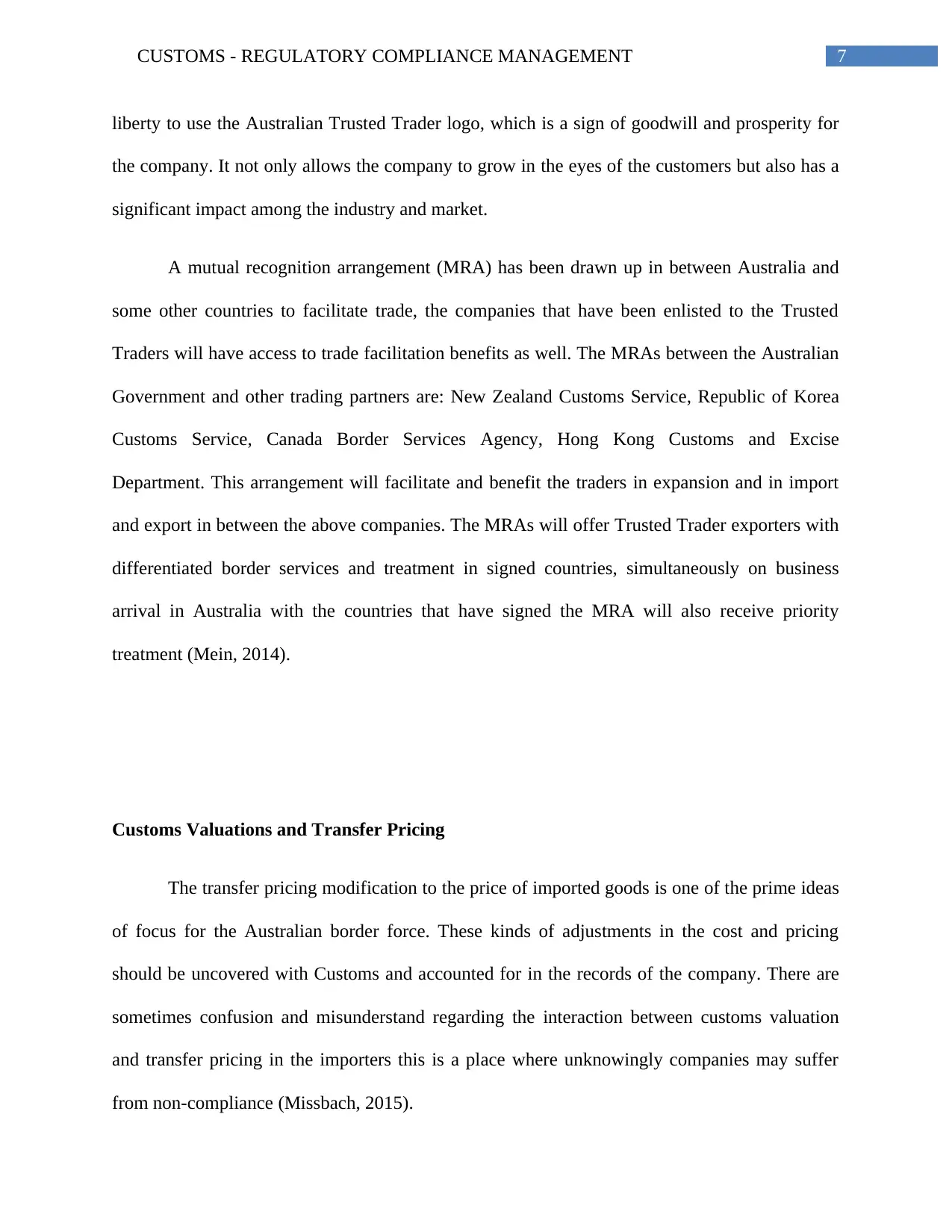
7CUSTOMS - REGULATORY COMPLIANCE MANAGEMENT
liberty to use the Australian Trusted Trader logo, which is a sign of goodwill and prosperity for
the company. It not only allows the company to grow in the eyes of the customers but also has a
significant impact among the industry and market.
A mutual recognition arrangement (MRA) has been drawn up in between Australia and
some other countries to facilitate trade, the companies that have been enlisted to the Trusted
Traders will have access to trade facilitation benefits as well. The MRAs between the Australian
Government and other trading partners are: New Zealand Customs Service, Republic of Korea
Customs Service, Canada Border Services Agency, Hong Kong Customs and Excise
Department. This arrangement will facilitate and benefit the traders in expansion and in import
and export in between the above companies. The MRAs will offer Trusted Trader exporters with
differentiated border services and treatment in signed countries, simultaneously on business
arrival in Australia with the countries that have signed the MRA will also receive priority
treatment (Mein, 2014).
Customs Valuations and Transfer Pricing
The transfer pricing modification to the price of imported goods is one of the prime ideas
of focus for the Australian border force. These kinds of adjustments in the cost and pricing
should be uncovered with Customs and accounted for in the records of the company. There are
sometimes confusion and misunderstand regarding the interaction between customs valuation
and transfer pricing in the importers this is a place where unknowingly companies may suffer
from non-compliance (Missbach, 2015).
liberty to use the Australian Trusted Trader logo, which is a sign of goodwill and prosperity for
the company. It not only allows the company to grow in the eyes of the customers but also has a
significant impact among the industry and market.
A mutual recognition arrangement (MRA) has been drawn up in between Australia and
some other countries to facilitate trade, the companies that have been enlisted to the Trusted
Traders will have access to trade facilitation benefits as well. The MRAs between the Australian
Government and other trading partners are: New Zealand Customs Service, Republic of Korea
Customs Service, Canada Border Services Agency, Hong Kong Customs and Excise
Department. This arrangement will facilitate and benefit the traders in expansion and in import
and export in between the above companies. The MRAs will offer Trusted Trader exporters with
differentiated border services and treatment in signed countries, simultaneously on business
arrival in Australia with the countries that have signed the MRA will also receive priority
treatment (Mein, 2014).
Customs Valuations and Transfer Pricing
The transfer pricing modification to the price of imported goods is one of the prime ideas
of focus for the Australian border force. These kinds of adjustments in the cost and pricing
should be uncovered with Customs and accounted for in the records of the company. There are
sometimes confusion and misunderstand regarding the interaction between customs valuation
and transfer pricing in the importers this is a place where unknowingly companies may suffer
from non-compliance (Missbach, 2015).
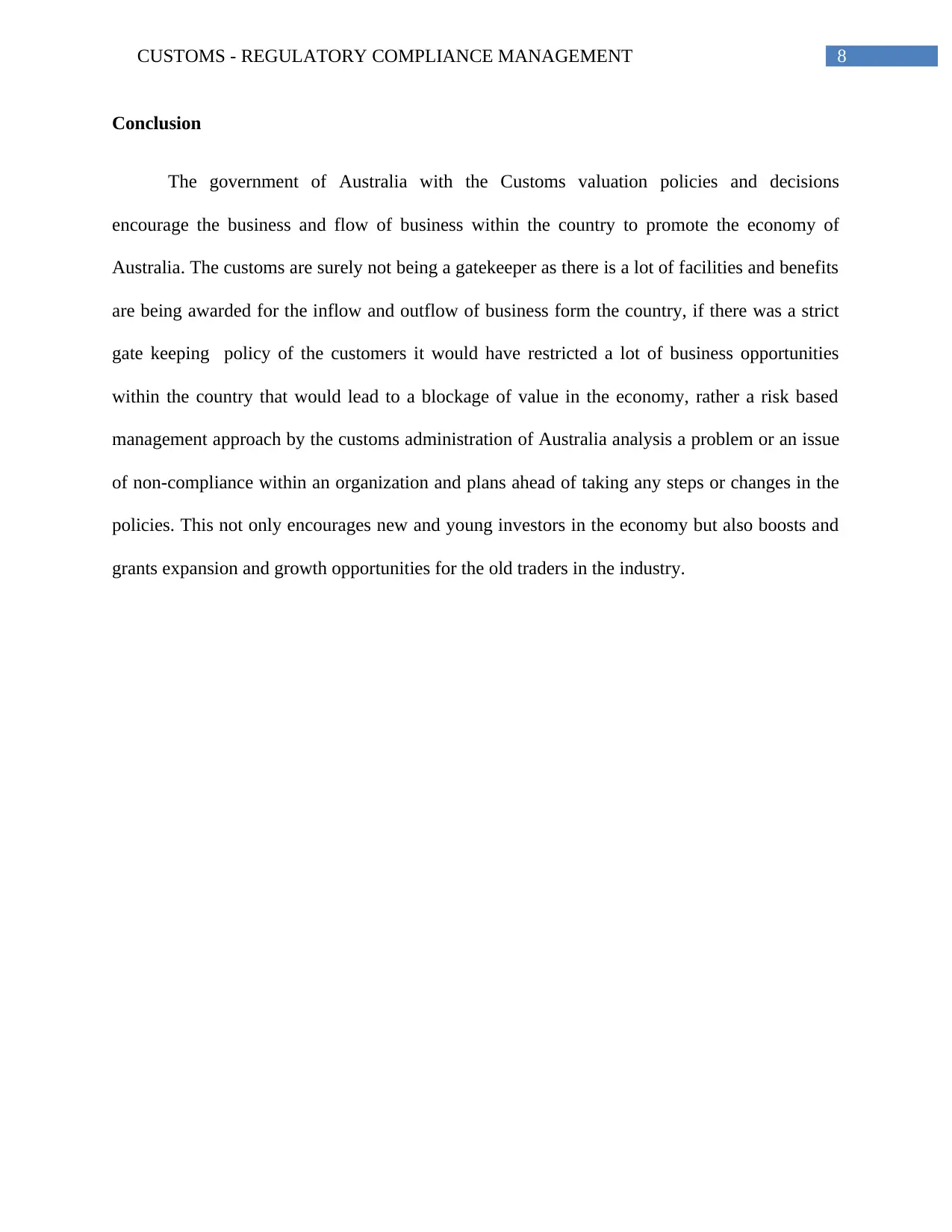
8CUSTOMS - REGULATORY COMPLIANCE MANAGEMENT
Conclusion
The government of Australia with the Customs valuation policies and decisions
encourage the business and flow of business within the country to promote the economy of
Australia. The customs are surely not being a gatekeeper as there is a lot of facilities and benefits
are being awarded for the inflow and outflow of business form the country, if there was a strict
gate keeping policy of the customers it would have restricted a lot of business opportunities
within the country that would lead to a blockage of value in the economy, rather a risk based
management approach by the customs administration of Australia analysis a problem or an issue
of non-compliance within an organization and plans ahead of taking any steps or changes in the
policies. This not only encourages new and young investors in the economy but also boosts and
grants expansion and growth opportunities for the old traders in the industry.
Conclusion
The government of Australia with the Customs valuation policies and decisions
encourage the business and flow of business within the country to promote the economy of
Australia. The customs are surely not being a gatekeeper as there is a lot of facilities and benefits
are being awarded for the inflow and outflow of business form the country, if there was a strict
gate keeping policy of the customers it would have restricted a lot of business opportunities
within the country that would lead to a blockage of value in the economy, rather a risk based
management approach by the customs administration of Australia analysis a problem or an issue
of non-compliance within an organization and plans ahead of taking any steps or changes in the
policies. This not only encourages new and young investors in the economy but also boosts and
grants expansion and growth opportunities for the old traders in the industry.
⊘ This is a preview!⊘
Do you want full access?
Subscribe today to unlock all pages.

Trusted by 1+ million students worldwide
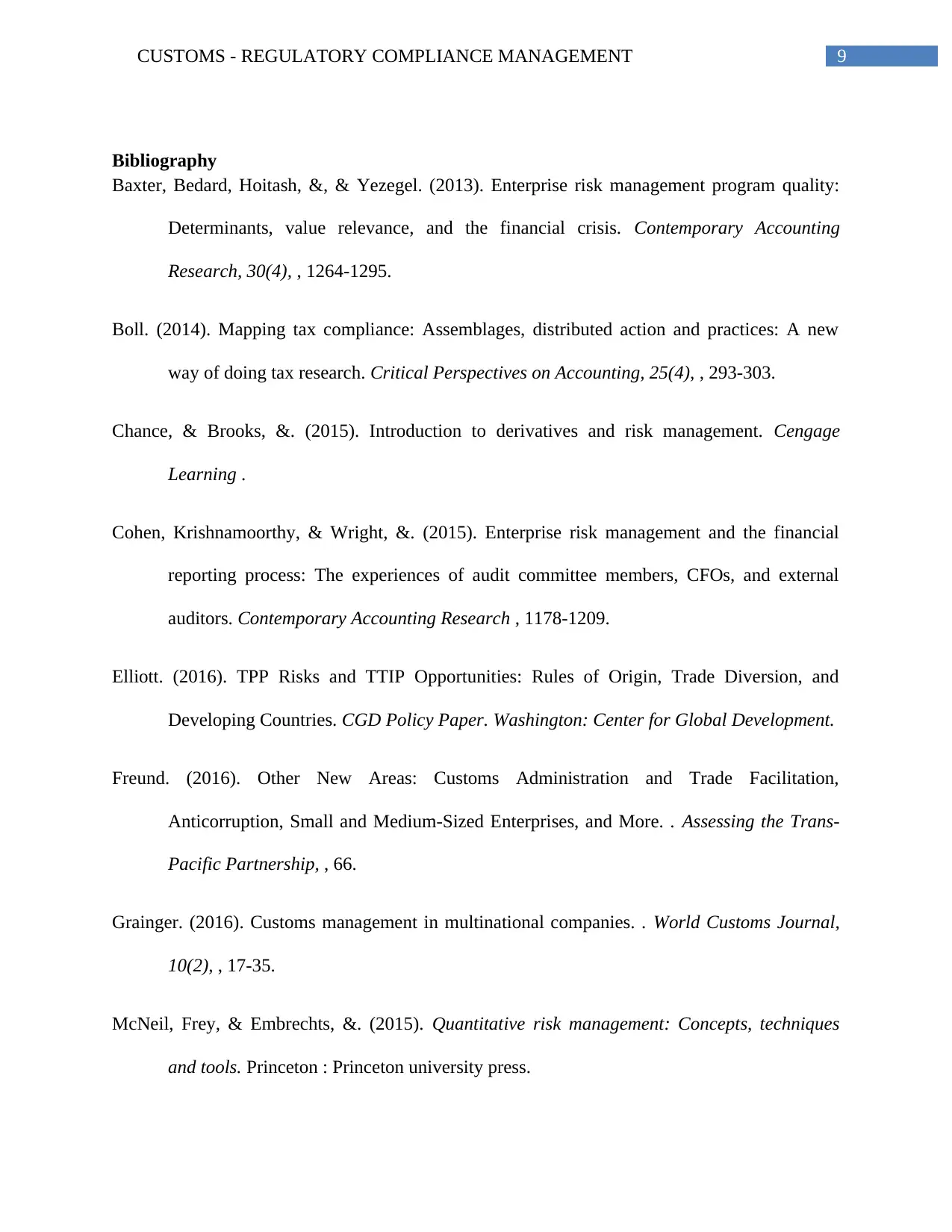
9CUSTOMS - REGULATORY COMPLIANCE MANAGEMENT
Bibliography
Baxter, Bedard, Hoitash, &, & Yezegel. (2013). Enterprise risk management program quality:
Determinants, value relevance, and the financial crisis. Contemporary Accounting
Research, 30(4), , 1264-1295.
Boll. (2014). Mapping tax compliance: Assemblages, distributed action and practices: A new
way of doing tax research. Critical Perspectives on Accounting, 25(4), , 293-303.
Chance, & Brooks, &. (2015). Introduction to derivatives and risk management. Cengage
Learning .
Cohen, Krishnamoorthy, & Wright, &. (2015). Enterprise risk management and the financial
reporting process: The experiences of audit committee members, CFOs, and external
auditors. Contemporary Accounting Research , 1178-1209.
Elliott. (2016). TPP Risks and TTIP Opportunities: Rules of Origin, Trade Diversion, and
Developing Countries. CGD Policy Paper. Washington: Center for Global Development.
Freund. (2016). Other New Areas: Customs Administration and Trade Facilitation,
Anticorruption, Small and Medium-Sized Enterprises, and More. . Assessing the Trans-
Pacific Partnership, , 66.
Grainger. (2016). Customs management in multinational companies. . World Customs Journal,
10(2), , 17-35.
McNeil, Frey, & Embrechts, &. (2015). Quantitative risk management: Concepts, techniques
and tools. Princeton : Princeton university press.
Bibliography
Baxter, Bedard, Hoitash, &, & Yezegel. (2013). Enterprise risk management program quality:
Determinants, value relevance, and the financial crisis. Contemporary Accounting
Research, 30(4), , 1264-1295.
Boll. (2014). Mapping tax compliance: Assemblages, distributed action and practices: A new
way of doing tax research. Critical Perspectives on Accounting, 25(4), , 293-303.
Chance, & Brooks, &. (2015). Introduction to derivatives and risk management. Cengage
Learning .
Cohen, Krishnamoorthy, & Wright, &. (2015). Enterprise risk management and the financial
reporting process: The experiences of audit committee members, CFOs, and external
auditors. Contemporary Accounting Research , 1178-1209.
Elliott. (2016). TPP Risks and TTIP Opportunities: Rules of Origin, Trade Diversion, and
Developing Countries. CGD Policy Paper. Washington: Center for Global Development.
Freund. (2016). Other New Areas: Customs Administration and Trade Facilitation,
Anticorruption, Small and Medium-Sized Enterprises, and More. . Assessing the Trans-
Pacific Partnership, , 66.
Grainger. (2016). Customs management in multinational companies. . World Customs Journal,
10(2), , 17-35.
McNeil, Frey, & Embrechts, &. (2015). Quantitative risk management: Concepts, techniques
and tools. Princeton : Princeton university press.
Paraphrase This Document
Need a fresh take? Get an instant paraphrase of this document with our AI Paraphraser
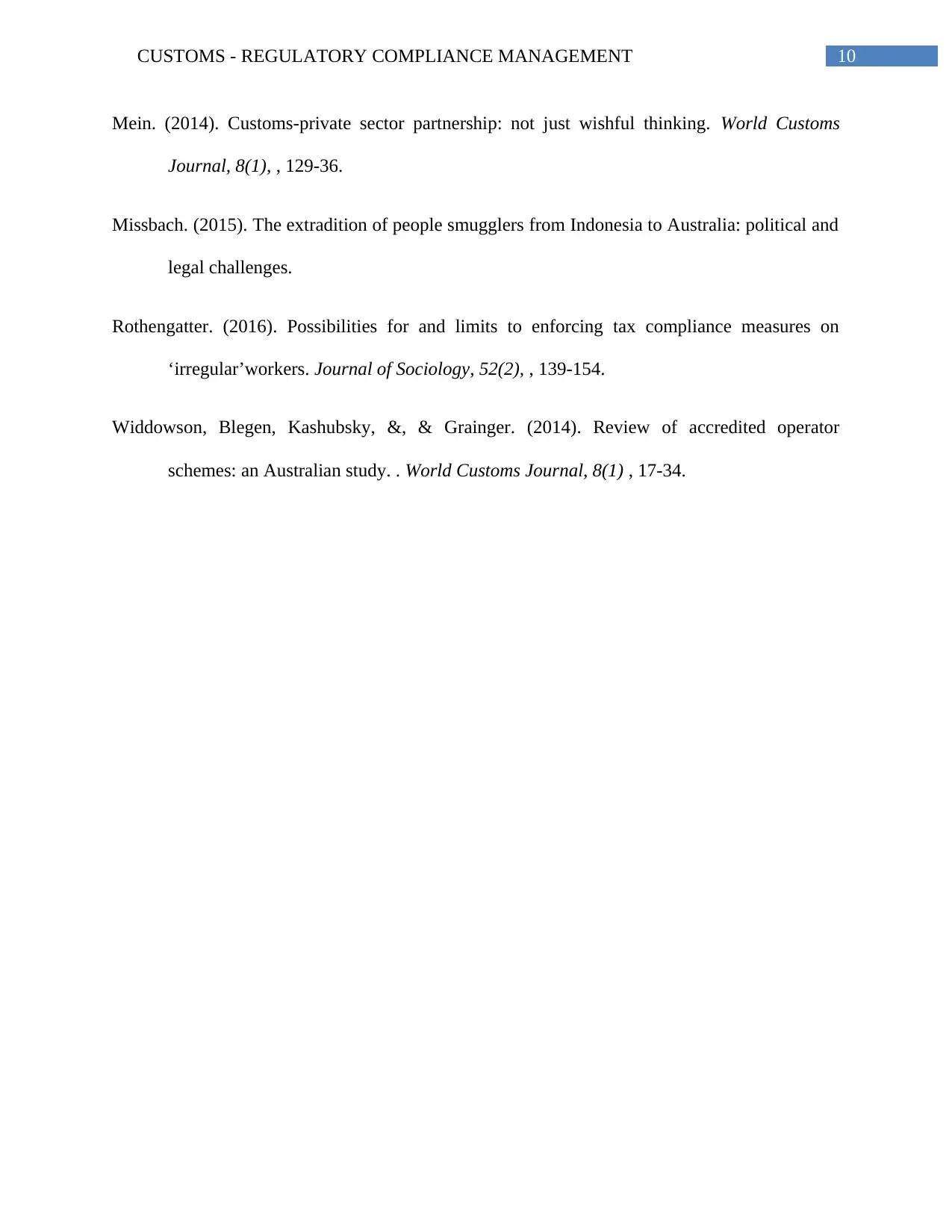
10CUSTOMS - REGULATORY COMPLIANCE MANAGEMENT
Mein. (2014). Customs-private sector partnership: not just wishful thinking. World Customs
Journal, 8(1), , 129-36.
Missbach. (2015). The extradition of people smugglers from Indonesia to Australia: political and
legal challenges.
Rothengatter. (2016). Possibilities for and limits to enforcing tax compliance measures on
‘irregular’workers. Journal of Sociology, 52(2), , 139-154.
Widdowson, Blegen, Kashubsky, &, & Grainger. (2014). Review of accredited operator
schemes: an Australian study. . World Customs Journal, 8(1) , 17-34.
Mein. (2014). Customs-private sector partnership: not just wishful thinking. World Customs
Journal, 8(1), , 129-36.
Missbach. (2015). The extradition of people smugglers from Indonesia to Australia: political and
legal challenges.
Rothengatter. (2016). Possibilities for and limits to enforcing tax compliance measures on
‘irregular’workers. Journal of Sociology, 52(2), , 139-154.
Widdowson, Blegen, Kashubsky, &, & Grainger. (2014). Review of accredited operator
schemes: an Australian study. . World Customs Journal, 8(1) , 17-34.
1 out of 11
Related Documents
Your All-in-One AI-Powered Toolkit for Academic Success.
+13062052269
info@desklib.com
Available 24*7 on WhatsApp / Email
![[object Object]](/_next/static/media/star-bottom.7253800d.svg)
Unlock your academic potential
Copyright © 2020–2025 A2Z Services. All Rights Reserved. Developed and managed by ZUCOL.





